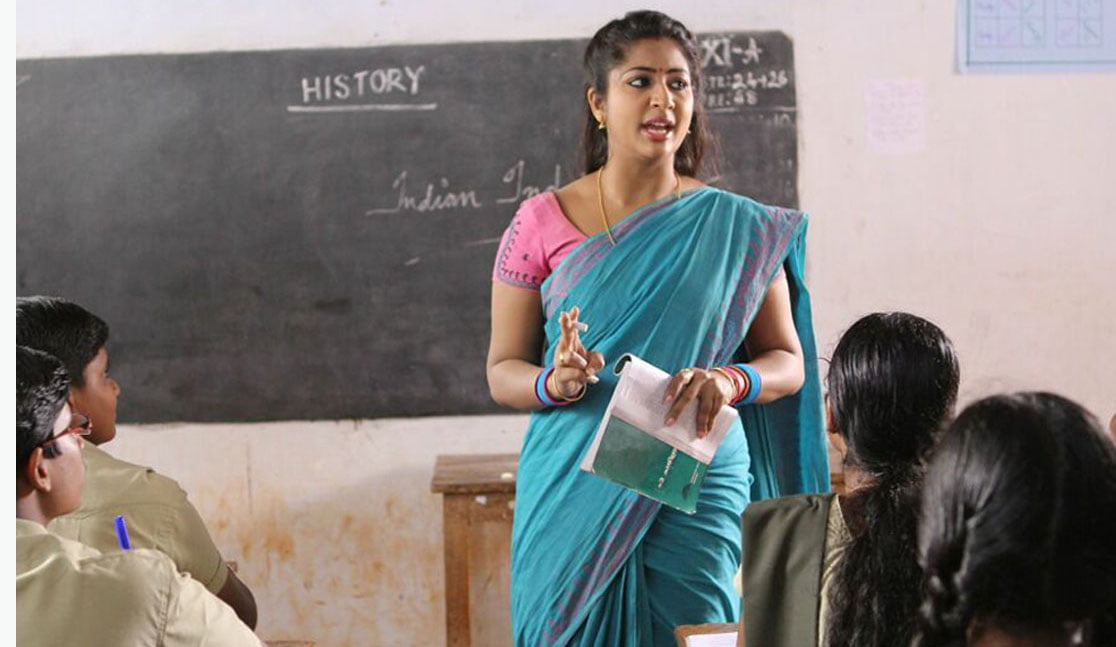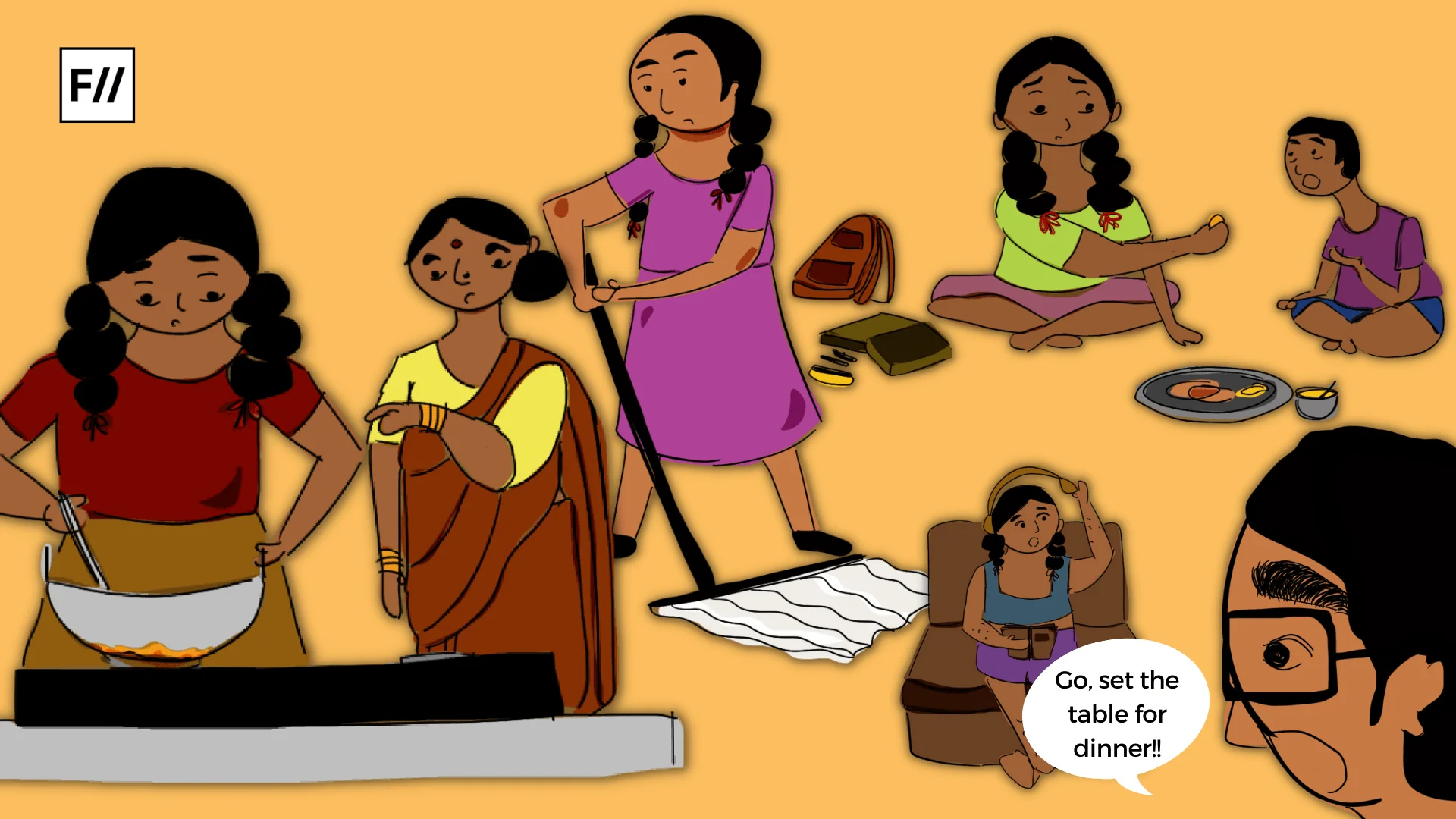When the Kerala government rolled out a first-of-its kind series of online classes on Jun 1, 2020, many of the sessions were led by female government-school teachers, all of them, irrespective of age, dressed in sarees in conformity with the traditional professional attire of female school and college teachers in Kerala. They made headlines for both the right and wrong reasons. Within hours of the classes going on-air, many online trolls started circulating memes and clips of a particular female teacher in a blue saree; “blue saree teacher” fans and clubs mushroomed all over social media, and in a blatant disregard for privacy, the name and photograph of the teacher got widely circulated.
They generated comments ranging from admiration for the teacher’s good looks and expression of their romantic interest to outright objectification of her body. Curious to know if there was anything “special” about this teacher that provoked such intense online frenzy, I watched her class on YouTube. I saw a smart, young woman, looking impeccable in a saree, draped in the standard fashion of a white-collar working woman, enthusiastically trying to lead an interactive class with a group of 12th grade students. To me, the apparent ordinariness of the teacher stood in sharp contrast to the lewdness and display of male desire that was elicited.
To be fair, there was a public outcry in social media against these depictions and discussions and the Kerala police was quite proactive in shutting down the circulation of such deplorable content. Several social media users, many of them young men, minced no words in condemning the content and the mindsets of the propagators of such content. However, the instinct to exceptionalise such acts and attribute it to a handful of perverts, fails to acknowledge the dominant sexualisation of the female teacher among male students, especially senior schoolboys. Few may express their teacher-centered sexual fantasies in public, but incidents such as the “bois locker room” controversy point to the prevalence and acceptability of sexualised and vulgar depictions of women’s body, including that of the teachers’, in spaces of adolescent male bonding and identity formation.
Within hours of the classes going on air, many online trolls started circulating memes and clips of a particular female teacher in a blue saree; “blue saree teacher” fans and clubs mushroomed all over social media and in a blatant disregard for privacy, the name and photograph of the teacher got widely circulated. They generated comments ranging from admiration for the teacher’s good looks and expression of their romantic interest to outright objectification of her body.
In this context, it is important to trace how the sexualisation of the female teacher’s body exists hand-in-hand with the policing of the same body in the name of entrenched gendered professional expectations and tradition. The imposition of the saree is a case in point. In Kerala, in spite of government orders stating that saree should not be made compulsory for female teachers and that they should be allowed to wear churidar/salwar if they wish so, many government-aided/unaided schools and colleges continue to impose the unwritten saree-code on women.
The reasons are many—tradition, dignity, a marker to differentiate between teacher and student, a symbol of authority, and so on. Ironically, the advocates of the saree seem to conveniently overlook the fact that in addition to being a signifier of maternal authority, the saree is a highly eroticised piece of garment. Anybody who is familiar with the topography of Indian male sexual fantasies knows that the saree-clad “hot” teacher is a dominant trope in male generated pornography and movies. One may argue that it’s the age and hormones, and that it is natural for adolescent boys to have sexual thoughts about the female bodies that they encounter, irrespective of what the women wear.

It may be true to a certain extent, but the saree is quite distinct from other kinds of women’s formal wear commonly worn now in India; it has a long history of being eroticised and its capability to accentuate the feminine form and stoke male desire has been amply exploited by popular media. Also, more importantly, being an unstitched garment, draping a saree and holding it in place requires skill and practice, and women have varying proficiency in draping it to their satisfaction.
Thus, imposing the saree can force, at least a section of women, to partially relinquish control over their bodies, severely compromising their ability to respond to and manage the sexualisation of their bodies in the classroom. It wouldn’t be surprising if a novice in a saree, aware of the male gazes on her body constantly frets about the pleats and wonders how much of her midriff and bosom is out on display. It can limit her agency to deal with any wrong kind of attention that she may receive, and this can, in turn, undermine her confidence and affect her teaching performance.
Thus, imposing the saree can force, at least a section of women, to partially relinquish control over their bodies, severely compromising their ability to respond to and manage the sexualisation of their bodies in the classroom. It wouldn’t be surprising if a novice in a saree, aware of the male gazes on her body constantly frets about the pleats and wonders how much of her midriff and bosom is out on display. It can limit her agency to deal with any wrong kind of attention that she may receive, and this can, in turn, undermine her confidence and affect her teaching performance.
Also read: Genda Phool: Misogyny In Songs Continue Despite #MeToo Along With Plagiarism
Like in many other spaces where women face sexual harassment, when female teachers complain of the “roving eyes” of the male students, they are advised to drape sarees non-provocatively and modestly, and some schools in Kerala even go to the extent of making them wear a coat over their sarees to ward off indecent gazes. Thus, the solution almost always seems to rest on subjecting women’s body to even more policing.
Also, idealized cultural stereotypes of teachers and students treat them as asexual beings, ignoring their bodies and bodily urges that can come into play in teacher-student interactions. Hence, female teachers often feel compelled to ignore or stay silent about sexual misbehavior from students. More often than not, she is expected to become the nurturing–authoritative figure to her male students as well as “discreetly handle” the sexual attention her body receives from them. To speak out against it, or even perceive it as sexual harassment is seen as the professional incompetency of the teacher.
She may be justified in not wanting to let the merits of her hard work and the government’s experiment in education get drowned in discussions about the perversion of the viewers; but the truth remains that in Kerala, many female teachers are caught in limbo—their susceptibility to sexualisation increased by institutional policing and professional expectations forcing to them gloss over sexual harassment in classrooms.
Studies and accounts from secondary schools in Finland and UK show that teachers often side-step the issue or tide over it by sheer strength of personality in order to not be perceived as failures. Several of them privately admitted that they were traumatized and were fearful of the senior boys. Sometimes sexual harassment of teachers by students manifests in ways which are impossible to ignore.
For example, in instances of arrogant display of toxic masculinity, in 2018, a class 7 student of a posh school in Gurugram publicly threatened via Instagram to rape his teacher and her daughter, and a class 8 boy from the same school wrote an email to his teacher, inviting her for “candle-night dinner and sex”. Though the teachers complained, they were asked to hush up and not generate negative publicity for the school. Thus, our schools and colleges are neither inclined nor equipped to address instances of sexual misbehavior towards teachers by students.
In the meanwhile, in an interview that was given by the said teacher, to an online portal following the incident, Arooja Denny—the “blue saree teacher”—tries to downplay the male attention that she received and opines that it will be petty and embarrassing to get affected by it. She may be justified in not wanting to let the merits of her hard work and the government’s experiment in education get drowned in discussions about the perversion of the viewers; but the truth remains that in Kerala, many female teachers are caught in limbo—their susceptibility to sexualisation increased by institutional policing and professional expectations forcing to them gloss over sexual harassment in classrooms.
Also read: Fatness, Womanhood And The Bois Locker Rooms
Will sexualisation stop if female teachers stop wearing saree?
Of course not. However, a more flexible dress code will go a long way in helping them gain more ownership over their bodies in classrooms and empower them to respond to sexual misbehavior more effectively. Also, breaking the taboo around speaking about sexualisation and sexual harassment of teachers to adolescent students will open up discussions on respect and objectification of body which are necessary for any progressive change in gender interactions.
Vinita is a doctoral candidate at the Department of English, University of Hyderabad. She is interested in thinking and writing about gender, academia and ethics and waste-human interactions. You can find her on Facebook and Instagram.
Featured Image Source: OTV




